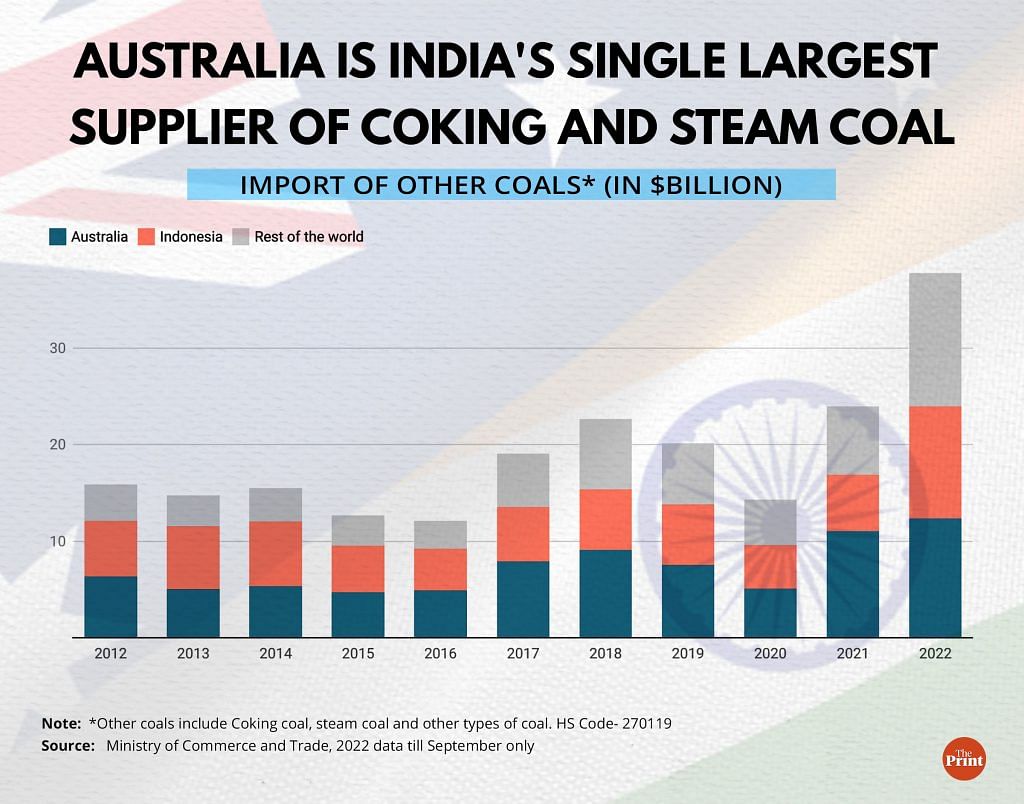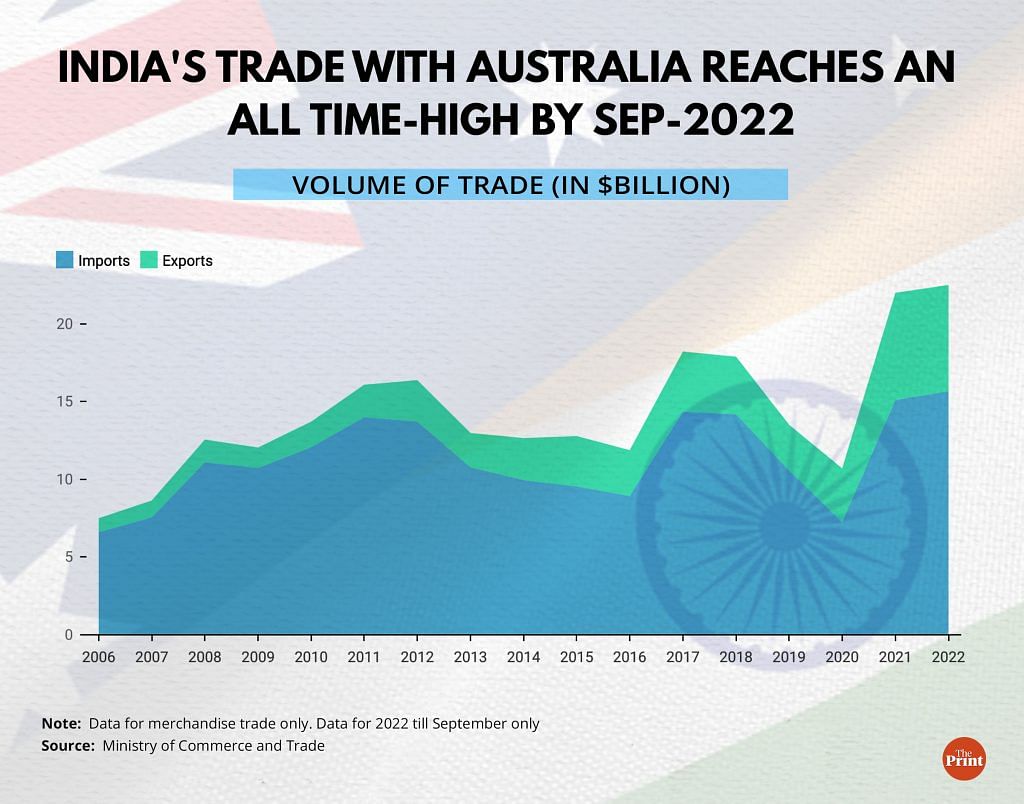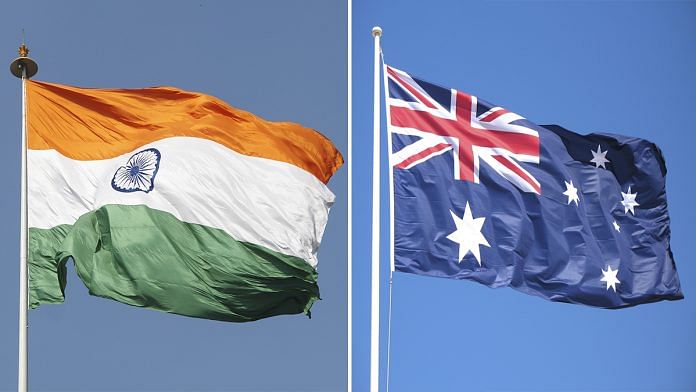New Delhi: The India-Australia Free Trade Agreement (FTA), approved by the Parliament of Australia Tuesday, comes at a time when trade between the two countries is already at record high levels.
Data with the Ministry of Commerce and Industry shows that India’s trade with Australia had already reached $22.49 billion in the first three quarters of this calendar year, a 62 percent jump over the $13.88 billion during the same period in 2021.
Indeed, India’s trade with Australia in the first three quarters of 2022 has surpassed the $21.98 billion worth of trade done in the entire year 2021.
Also Read: As Australia clears free trade pact, India hopes to tap into its minerals, curb reliance on China
Energy sector driving the growth
India’s merchandise trade with Australia is driven heavily by imports from the latter. Of the $22.49 billion of trade this year, imports accounted for more than $15.6 billion and exports only for $6.83 billion.
A closer look at these numbers reveals that most of the trade between the two countries happened in the energy sector. Of the $15.6 billion imports from Australia this year, coking coal ($9.56 billion), steam coal ($1.4 billion), and other forms of coal ($1.37 billion) accounted for close to 80 per cent of the total imports from Australia. Coking coal is a major input, good for iron and steel manufacturers, while steam coal is used by industries to produce steam to generate electricity and for heating purposes.
Australia is India’s single biggest source for coking coal. In 2022 (till September), it accounted for more than 57 per cent ($9.56 billion) of India’s coking coal needs ($16.48 billion).

Similarly, energy products dominate India’s exports to Australia. By September 2022, automotive diesel fuel, high-speed diesel and automotive gasoline alone accounted for more than 55 per cent of India’s exports to Australia this year.
Data also reveals that the pace of growth of India’s exports to Australia is much faster than that of the imports. In the first three quarters of 2017, India’s total Australian imports were worth about $14.35 billion, which rose to $15.56 billion in 2022 — or an average growth of 7.8 per cent per year.
But India’s exports over the same period rose from about $2.8 billion to $6.8 billion, or a 19 per cent average annual growth rate.

Benefiting labour-intensive sectors
According to Saon Ray, professor at the Indian Council for Research on International Economic Relations (ICRIER), “The ECTA (Economic Cooperation and Trade Agreement) is likely to be beneficial for Indian exports that are labour-intensive in sectors such as textiles, apparel, agriculture products, fish products, leather, footwear, furniture, sports goods, jewellery, engineering goods, and some pharmaceuticals and medical devices (according to media reports)”.
“Many raw materials and intermediate goods are of interest to India. Items that are of interest to India include plastics, in which Australia is more protective,” she said.
The Harmonized System, administered by the World Customs Organization, is an international nomenclature used to classify traded goods. Referring to chapter 39 of the system’s codes — plastics and articles thereof — Ray added, “Some items are sensitive in this chapter, though most items are expected to be liberalised.”
Ray also said that India may also benefit from exports of certain services.
“Among the services in which Australia is competitive (and India is not) are postal and courier services, travel and government goods and services n.i.e. (not included elsewhere). Service categories that India would like to export to Australia include other commercial services, computer and information services, and other business services,” she added.
Diversification possible?
After the announcement of the FTA with Australia, Piyush Goyal, minister of commerce and trade, said that this move would open up markets across 6,000 broad Indian sectors that could include final goods such as textiles, jewellery and machinery.
At a function, he also said that Australia could now benefit from Indian steel, the export duty on which was abolished six months after being levied.
Several industry experts, too, have said that this deal would bolster India’s exports in the non-energy sector.
Vivek Chandra, chair of the food processing and value additions council at the Associated Chambers of Commerce and Industries (ASSOCHAM) India — a non-governmental trade body — in a tweet said the FTA would open up more mutually beneficial avenues and new technology to “enhance the industry with the expansion of India’s food processing sector”.
Additionally, in April this year, the Australian government had already agreed on amending laws to abolish double taxation for Indian IT firms operating in Australia. It is also envisioned that import duty on select Australian wines will come down.
(Edited by Geethalakshmi Ramanathan)
Also Read: ‘There’s a panda in the room’: Why Australia signed historic free trade pact with India



